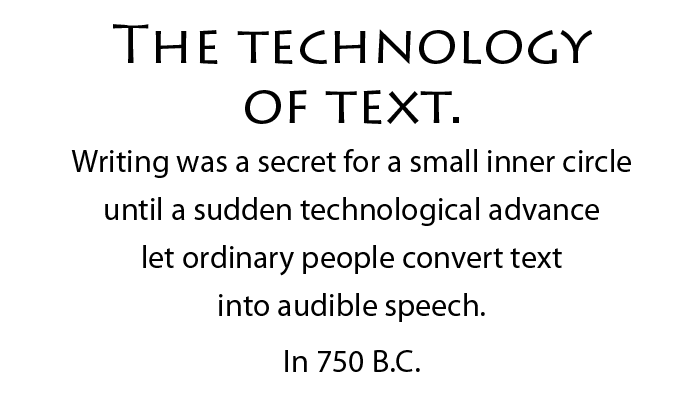 Greece was just another grubby little kingdom until King Cadmus imported the Phoenician alphabet. In an accident of fate, Phoenician used five more letters than the Greeks needed for their language. Cadmus made the huge technological advance of using those extra letters as vowels.
Greece was just another grubby little kingdom until King Cadmus imported the Phoenician alphabet. In an accident of fate, Phoenician used five more letters than the Greeks needed for their language. Cadmus made the huge technological advance of using those extra letters as vowels.
Writing had been a secret reserved for kings and priests and tax collectors, a code of letters without vowels–an unending stream of acronyms. DSRPTV SLTNS was easy enough to read if you were already one of the cool kids, but by inserting vowels, suddenly everybody could read “disruptive solutions.”
Inserting vowels instantly made the alphabet a killer app that converted text into speech, and vice versa. Text became easy to read. Text suddenly became a flowing transcription of human speech that anybody could decode simply by speaking it aloud.
Instead of its former role as a means of secret communications within a cabal, writing became a massive new channel of sharing.
“Apes could start using a primitive language today if their motivation to keep secrets gave way to a motivation to share knowledge.”
–Edmund Blair Bolles, BABEL’S DAWN.
When information became easy to share, the accumulation of knowledge turned asymptotic. Within a few generations Greece became the foundation of Western thought and literature. Socrates worried that making literacy easily available to all would result in the destruction of human powers of memory. He was right. Why bother to memorize the ILIAD when you can just look up any passage in a hard-copy print version. Write-once, read-many.
Over the centuries, further improvements made text easier and easier to read. Instead of one long line of letters, spaces were inserted to show where individual words started and stopped. Punctuation was another late invention. The pace of improvement increased after moveable type made mass printing available.
And now, corporate culture is abandoning the technology of text. They are reverting text to the role of protective camouflage, a deflective shield to prevent sharing of information. Text is old and outdated, it can’t compete against YouTube and music.
Companies display text to comply with regulations, without regard for the fact that text is a technology that requires an operator: a person who actively extracts the thought and meaning behind the words.
Typography bears much resemblance to cinema, just as the reading of print puts the reader in the role of movie projector.
–Marshall McLuhan
Amid the worldwide media glut, companies no longer care if people read their text: their goal is merely to plunk the text into your view-space. With the right magic SEO dust inserted into the text, the robots will deliver your text directly to your most highly qualified leads. But will they read it?
Companies fret that their story is not getting out, but at the same time they publish text that leaves readers feeling they are wading through tar. And if that isn’t enough to prevent the sharing of their information, they present it in ways that visually block the message.
Here’s some kind of internet-of-things headline. The search bots can read it easily. How about you?

This text that you visually cannot read has a Reading Ease score of negative 12 and a Grade Level of 22, according to the Flesch-Kincaid Readability Index. If you battle your way through this illegible text, you learn–nothing. The sentence is an assemblage of vague abstractions. It can only leave readers impatient and irritated at having wasted their time.
The first goal of effective text should be to reward the reader’s time. We have the technology! Why won’t companies use it?